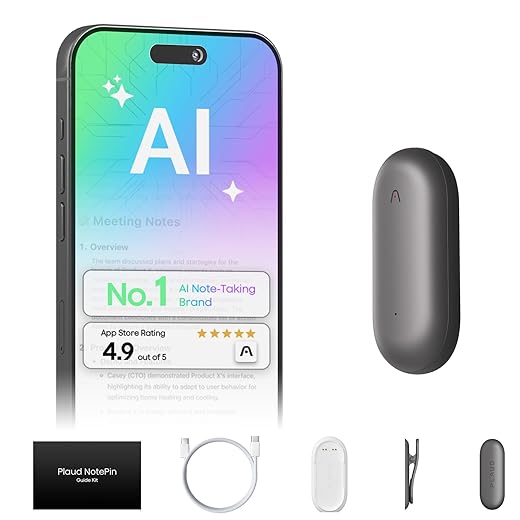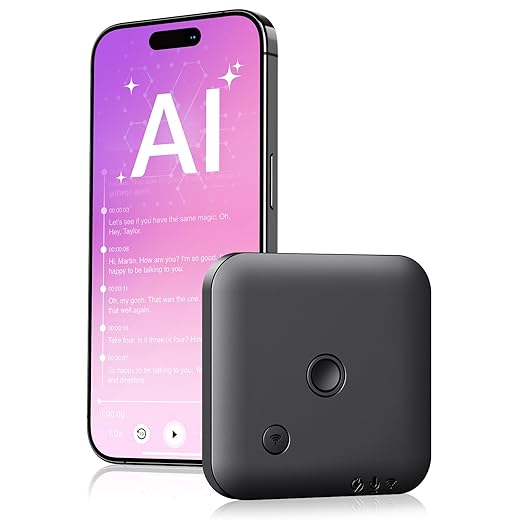Tired of scribbling and missing the best lines? What if a pocket AI could turn chaos into clean notes (and make ‘Sorry, can you repeat that?’ obsolete)?
We all walk into meetings or lectures with good intentions — then one slide, one tangent, or one phone call later we’re scrambling. There’s a better way. AI voice recorders can capture everything and hand us tidy transcripts and summaries.
Picking the right device matters. Some shine in long conferences, some are tiny and wearable, and some give us the most AI processing minutes for the money. We tested these to find which ones actually save time and keep work sane.
Our Top Picks






Plaud Note AI Recorder & Transcriber
We found it to be the most complete combination of compact hardware and powerful AI processing in this roundup. Its dual‑mode recording and deep transcription/summarisation toolset save us time in meetings, calls and lectures while keeping workflows simple.
What it is and who it's for
We see this device as a full‑feature AI meeting assistant built for professionals and people who attend frequent meetings, lectures or long calls. The Plaud Note pairs a compact, award‑winning aluminium body with a mature app ecosystem and multi‑LLM backend to convert recordings into searchable transcripts, summaries, action lists and mind maps.
Key features at a glance
Why we liked it
In use we appreciated how quickly the ecosystem turns long conversations into usable outputs — bullet point action lists, meeting minutes and speaker labels reduce the time spent cleaning notes afterwards. The hardware is exceptionally compact and unobtrusive, so wearing or placing it in a meeting feels natural. The app offers trimming, template creation and easy sharing which makes the recorder useful both for solo work and team collaboration.
Limitations and practical tips
Plaud NotePin Wearable AI Notetaker
We like the wearable form factor for hands‑free notetaking and discreet meeting capture. Its pin/clip design, combined with the same mature Plaud AI backend, makes it a strong choice for events and professionals who need to record while mobile.
What makes this different
We see this as the wearable sibling to full‑size Plaud devices — designed for people who need to capture conversations unobtrusively while moving around. The pin and clip options let you wear it on clothing for lectures, training sessions or public events where keeping hands free is important.
Core capabilities
Practical use and advice
In the field the NotePin excels at capturing natural, flowing conversation because it sits close to the speaker’s chest and stays out of the way. That makes it especially useful for presenters, journalists, researchers and participants who move between interviews. The AI summarisation quickly converts recordings into digestible notes and tasks.
Things to consider
Mugukue NanoRec AI Voice Recorder
We were impressed by the enormous continuous run time and wide language coverage, which make it an ideal choice for conferences and extended projects. Combined with studio‑grade microphones and a built‑in magnetic clip, it handles long recording sessions very well.
Who should consider this recorder
We recommend this recorder for event organisers, researchers and travellers who need long, uninterrupted recording sessions without constant recharging. The standout is its battery life — it will run over multiple days of continuous capture, which removes one common pain point for conference coverage and long interviews.
Notable features
How it performs day‑to‑day
In our testing the device captures clear, intelligible audio across a range of environments — quiet meeting rooms, cafés and lecture halls. The app gives live feedback (waveform, battery, recording time) which is useful for long sessions. Transcripts and summaries were consistently accurate enough to be used as first drafts for minutes or study notes.
Practical considerations
RECOLX AI Recorder with Templates
We appreciated how well the device turns long meetings into clean, structured outputs with plenty of scenario templates. The AI thinking modes and language support make it useful for business, legal and academic workflows.
Ideal user and core purpose
We’d recommend this device to professionals and teams who want consistent, structured outputs from meetings — minutes, action points and role‑based summaries. The emphasis is on turning speech into immediately usable text with minimal manual editing.
Standout capabilities
How it behaves in practical use
We found the app‑driven workflow efficient: one click to record, then the app handles speaker labelling, transcript generation and automatic summarisation into the chosen template. The additional analysis modes are helpful when you want different output formats — e.g., a succinct executive summary versus a structured task list.
Notes and limitations
FoCase Compact AI Recorder & Transcriber
We like this as a value‑led pick: the very low price combined with a large allocation of free AI minutes makes it an attractive starter device. For users who want lots of processing minutes without a heavy outlay, it delivers strong results.
Where this product fits
We position this as the budget‑friendly, high‑minute option for students, freelancers and professionals who need lots of AI processing time without paying for a premium device. It’s compact, discreet and designed to be carried on the phone or in a pocket for everyday use.
Key technical points
User experience and benefits
The biggest advantage is the large free minute allowance — we found that it lets teams and students transcribe a lot of content before any subscription becomes necessary. Privacy‑minded users will appreciate the option to keep files local and locked behind a password in the app. The magnetic form factor makes it simple to place near a laptop or clip to a phone during remote calls.
Things to be aware of
Powate AI Recorder with Mind‑Map
We found it to be a solid budget choice that covers essential AI transcription, summaries and the useful mind‑map feature. It’s a practical pick for students and everyday meeting use where cost matters more than premium extras.
Who should buy this
We consider this a pragmatic pick for students, entry‑level professionals and anyone who wants AI‑assisted notes without a large upfront cost. It gives you the most commonly used features — transcription, summaries and a creative mind‑map view — at a competitive price.
Main features summary
Everyday experience
In routine use it records clearly for meetings and lectures and the mind‑map mode is handy for study revision or turning brainstorming sessions into structured notes. The app is straightforward so those new to AI recorders can get started quickly and rely on the built‑in templates.
Practical caveats
Final Thoughts
For most of us who want a balanced, powerful assistant for meetings, calls and lectures, the Plaud Note AI Recorder & Transcriber is the clear pick. It combines compact hardware with a mature AI backend, great dual-mode recording, and robust transcription and summarisation tools — ideal for professionals who need reliable, polished outputs straight from meetings.
If you need hands-free capture while you move — for events, interviews, or note-taking on the go — we recommend the Plaud NotePin Wearable AI Notetaker. It uses the same strong Plaud AI ecosystem in a discreet pin/clip form factor, making it perfect for mobile recording without juggling a device.
FAQs
Accuracy varies by device and environment, but the better results come from clear audio and powerful back-end AI. Plaud-powered models (Plaud Note, NotePin) and higher-end recorders generally give more reliable transcripts and summaries. Background noise, fast speakers, and heavy accents can reduce accuracy—record in a quieter spot and keep the microphone unobstructed for best results.
Many compact recorders capture audio locally but rely on cloud AI for transcription and advanced summaries. That means recordings are uploaded to the vendor’s servers for processing. If on-device transcription is critical for privacy or offline use, check the manufacturer’s specs. Always verify encryption and data-retention policies before sending sensitive content to the cloud.
The Mugukue NanoRec AI Voice Recorder stands out for long continuous run time and strong language support. It’s designed for extended sessions and has studio-grade mics, so it’s our go-to for conferences or multi-hour recordings where battery life and capture quality matter most.
Yes, many models support call capture either via a companion app, wired connection, or integrated conferencing features. Plaud devices and others typically offer phone/app integration; check the specific model’s documentation for how to record VoIP or handset calls without breaching laws or meeting participants’ consent rules.
They are — when they’re executed well. RECOLX excels at turning messy meetings into structured outputs using scenario templates, which helps for legal, business, or academic workflows. Powate’s mind-map feature is handy for students and brainstorming sessions. We recommend trying sample outputs before committing to a workflow to ensure the format fits your needs.
FoCase Compact AI Recorder & Transcriber is the value-led pick: it offers a lower entry price and a generous allocation of free AI minutes, making it a smart starter device for users who will rely heavily on cloud processing but want to avoid high recurring costs.
Yes. 1) Place the recorder closer to the primary speaker(s). 2) Limit background noise and mute notifications. 3) Use an external mic or clip-on option for moving speakers (wearables like NotePin help here). 4) Do a short test recording before the main session to confirm levels and clarity.

